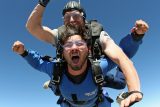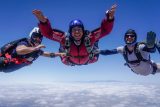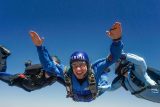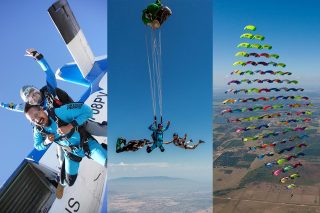People of Perris: James Perez
People Of Perris
Posted by: Skydive Perris
9 years ago
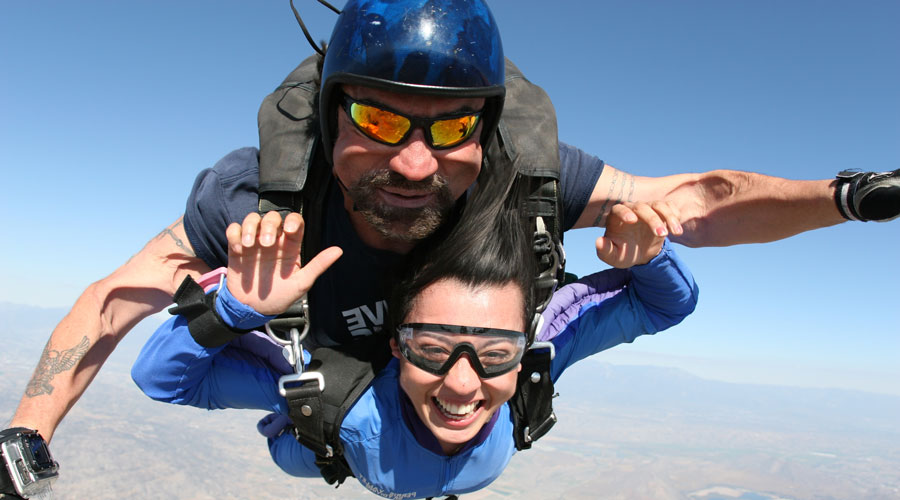
When, where, why and how did you make your first skydive?
Officially Aug. 1981 at Elsinore Para Center on a static line with a T-10 main and belly reserve. Some friends from work were going and invited me to go watch, not jump! Two weeks later myself and another co-worker decided to give it a try. I usually say my skydiving career started in Sept. 1990 though. My neighborhood buddies saw my first jump picture hanging in my house and the next thing I know I was volunteered to organize a skydiving trip. Out of the 9 who went myself and my friend Jeff stuck with the sport.
How many total jumps do you have and how many of these do you estimate are jumps with students?
I recently made jump number 10,000 and would guess that approximately 8,000 of those were with students. That wouldn’t count the static line/IAD dispatches I’ve done.
How did you get into instructing and what do you love about it?
In 1991 I put a video camera on my helmet to show friends what the view looked like on a jump. After about 25 jumps with the camera the DZO where I was jumping told me if I put a still camera on I could film tandems. I said no thanks. He said I would get $25 a jump. I had a still camera the next weekend and started filming students. I think I had about 125 jumps at the time. I saw how the students emotions went from fear prior to the jump to excitement during and to total jubilation after and decided I wanted to be a part of that experience. Shortly thereafter I started looking into getting my instructional ratings. In 1992 I got my initial rating as a Static Line JM. I followed that with a Tandem rating in 1994, an IAD rating in 1996 and finally an AFF rating in 1999. Without a doubt that was a tough one as I was unsuccessful in my first two attempts but finally achieving it in April 1999. I received a patch and a t-shirt. We commonly referred to this as our $1500 AFF-I t-shirt! In my case it was worth a bit more!
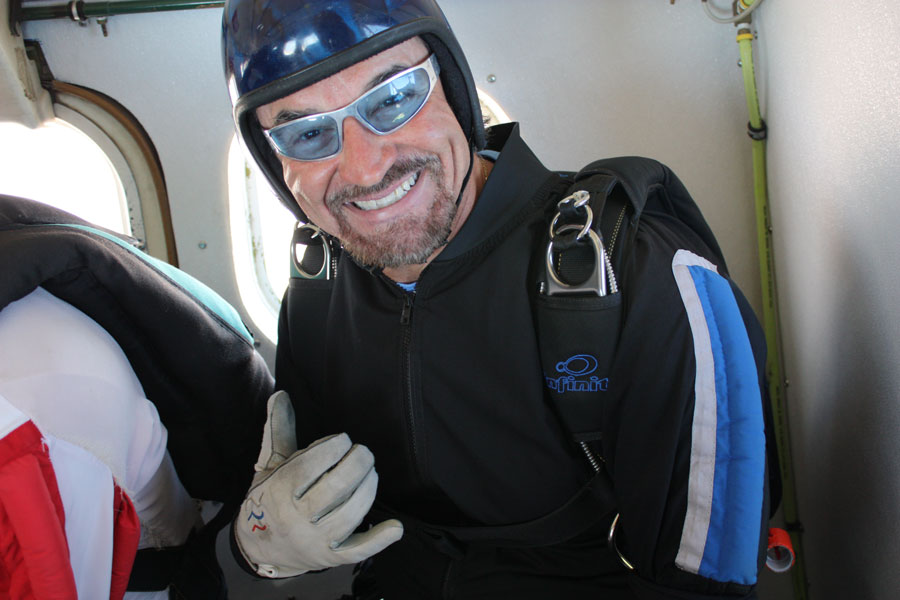
You’re an S&TA and the chief instructor at Skydive Perris, can you describe a typical day at work?
Don’t know if there is a typical day. As an S&TA most might think I’m out looking for someone breaking a DZ rule. But I’m not. Most of my duties as an S&TA is involved with administering license exams, verifying rating renewals, researching USPA BSR’s/recommendations or following up with the USPA when a jumper wants to know why he/she hasn’t received their license or rating yet. The only time we’re really visible is when we do have to have a talk with someone about a possible infraction. As a Chief Instructor it’s more of the same only centered more towards the student program. I try to keep the school program running smoothly. It could be dealing with a student who is questioning the way he is being evaluated by an instructor, running a new instructor through orientation to looking for replacement ear buds for the student radios. One of my responsibilities is watching student videos to ensure that we, the instructors, are following our safety practices. I don’t think anybody knows just how much time goes into that. That’s because the videos show they don’t need to be reminded.
You’ve taken many paraplegic and quadriplegic people on tandem skydives, how do these jumps differ to regular tandem skydives?
These are by far some of the most rewarding jumps I do. Because so many people with physical limitations are used to hearing ‘you can’t do that’ in everyday life that it can be such a emotional joyful experience if you can say ‘Yes, you can!’ to a tandem skydive. The biggest difference between a regular tandem and a special care tandem is the pre-jump preparation time. I like to meet the jumper and assess their limitations and brief them on the procedures including the use of a pulley system that lifts and locks their legs into suitable position for landing. I want to make sure they’re comfortable with the procedures, equipment and me. If they have an attendant or family member with them I usually rely on them for assistance during the gear up process. When boarding we need help lifting the passenger up into the plane from the loader and or other instructors. Generally we sit back by the door instead of up front as it makes it easier to move into position for exit and we’ll exit first. Probably the hardest part is setting up in the door as I have to support my weight, the passenger and gear. Once out the door it’s pretty much business as usual until after opening. An able bodied passenger would be able to lift their legs for landing whereas a paraplegic or quadriplegic isn’t. I use a pulley system that’s attached to their legs at the knees that allows me to lift their legs and locks them in place. With their legs already in a suitable position it’s one less thing I have to worry about on landing. This was designed in part by a friend of mine, a paraplegic, when she was skydiving. Under canopy I try and let them do as much as possible just as I would with any other tandem passenger including steering the parachute if they can. If we’re sliding in the landing I’ll lean back a little and they shouldn’t even come close to touching the ground. There’s always that feeling of excitement and celebration when anyone lands after their first jump, but I feel the vibe is just a little stronger with a special care tandem. Smiles are bigger, hugs are longer, cheers are louder and yes sometimes there are tears flowing.
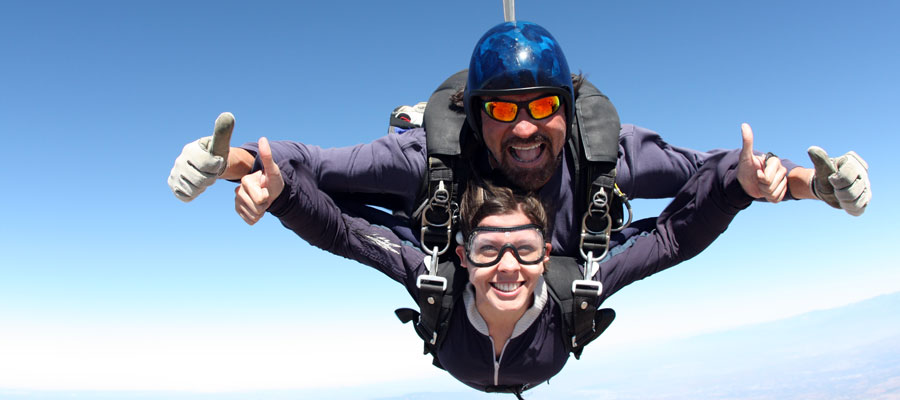
You’re also an instructor examiner for Tandem, Coach, AFF and Static Line, what is involved in getting these ratings?
First you must meet the requirements for each IE rating sought. For example, to attain an AFF IE rating you must have 500 AFF jumps, taught 50 FJC’s, conducted 50 AFF evaluation jumps in an AFF Instructor Rating Course and taught a AFF Instructor Rating Course under the supervision of a current AFF IE. There are similar requirements for all the Examiner ratings. In addition a candidate must attend the Instructor Examiner Rating Course for any Examiners rating sought. The process can be quite lengthy but the experience and knowledge you gain makes it all worthwhile. I believe it took me almost 3 years to attain my AFF IE. I am very lucky to know and have worked with some of the finest people in the sport who assisted me throughout my process by allowing me to work under their guidance and sharing their knowledge. Tom Noonan from UPT, Chuck McHugh from Strong Ent., Yong Chisholm (the sexy Korean Goddess) and especially Jay Stokes who I did the majority of my internship with. Without the help of these fine folks I don’t think I’d be where I am today. The fact is I’m still learning as I had the opportunity to sit through an IERC with Jay in March. I’m also paying back as I have been working with new evaluators and recently had one attain his AFF IE rating. It’s a good feeling!
What is your favorite part about making new instructors?
When I’m on a student jump, an AFF or filming a tandem, with a instructor who went through my course and I see that big wide-eyed smile on their face in freefall!
What is it about Skydive Perris that makes you want to work and play here?
#1 it’s a first class facility! It has everything for the skydiving community with a family friendly atmosphere. Huge landing area, plenty of aircraft, shaded packing area, restaurant and pool. A range of styles or disciplines to choose from, P3 events, Mark & Darryld jumps, freeflying and wingsuits, (yes, I like wingsuiters). A school that I think sets the standards with an excellent curriculum, experienced instructors, well maintained student gear and an excellent safety record. Most importantly a DZ leading the way when it comes to safety.

What has been your favorite jump to date?
Jumping onto a private beach in St. John’s, Virgin Islands with the Flying Elvi comes to mind. Doing a tandem certification course with the USAF out of a C-130 Hercules would be up there. A sunset load over the Sea of Cortez, in Puerto Penasco Mex., and landing on the beach with a margarita waiting for me was fun. But the most fulfilling had to be Jump For The Cause 2000 at Skydive Perris. I was the Tandem Instructor on a 35-way formation with a tandem in the base. My dear friend Coral Degagne was the passenger. We were celebrating Coral’s 35 birthday with a 35-way and in the process raised $50,000 for spinal cord research. Coral, who suffered a spinal cord injury as a teenager, had been jumping since her mid-twenties and had approximately 250 jumps, all tandems, at that time. It was my first time in the Parachutist magazine, a cover shot! What made it so special, besides the money raised, was the support from the skydiving community. From the Mfg’s. to the sponsors, skydivers on the formation or those just there to cheer us on and Skydive Perris who had faith that we could pull this off safely. It was fun, but exhausting day!
What canopies do you jump and why?
I presently jump Performance Design canopies. Katana 120, a Storm 135 & 150 and a Spectre 190. I have jumped other makes of canopies but from my early days of skydiving I’ve always liked PD products. Aside from making fantastic canopies they have, in my opinion, great customer service. The Katana is basically my everyday canopy. Great openings, fun to fly. The Storms and Spectres I use for course evaluation jumps as sometimes candidates have their hands all over me at deployment time and these canopies aren’t as sensitive and twitchy. I still have a PD 230 that along with my 190 I use for demos.
What advice do you have for anyone who is thinking about becoming an instructor?
PREPARE! Do the course pre-requisites listed on the proficiency card prior to attending any rating course. Not completing the pre-course requirements may prevent you from attending the course.
Work on your flying skills. With the exception of a SL or IAD rating course you will be tested and evaluated on your flying skills. With so many disciplines today in the sport many skydivers forget the basics when flying on your belly. Spend time before the course to hone your skills. For an AFF rating course one of the best ways is attending a pre-course. Arrive at the course relaxed with an open mind ready to learn. It takes more than just great flying skills to be a good instructor. And remember that even if you aren’t successful at a course you have still gained something…knowledge, and this will definitely help you down the road. Oh, and did I say PREPARE??
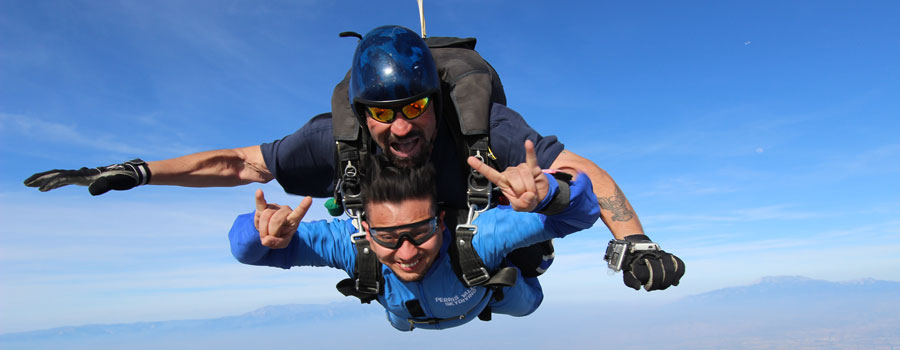
When you’re not skydiving, how do you like to spend your spare time?
Spare time?? What’s that? Actually I recently started riding again. I’ve been riding motorcycles since when I was in Jr. High School. Mini bikes, dirt bikes and eventually onto street bikes. I’ve owned a Yamaha and Hondas but now prefer Harleys. I’m not into riding fast, but prefer to cruise and enjoy the scenery. There are a few local Perris jumpers who like to ride so I hope to get a group together and do some riding this summer. I also scuba dive, go to concerts and go to museums of history. Some of my favorites were the Smithsonian, the Louisville Slugger museum and the Frazier History museum both in Louisville, KY. And now that the Rams are back in town I plan on watching a lot of football this upcoming season.
Tell us something that is little known about yourself?
In high school and college I played bass guitar in a rock band, Rogue Star, (I didn’t come up with the name!). We played cover songs at local parties. Didn’t make a lot of money but it was a great way to get free beer and meet girls! And I spent three years as a hospital cook which is why to this day I don’t eat in hospital cafeterias!
Sum up James Perez in 5 words or less.
Imperfect, (but aren’t we all?), reliable, fair, huggable (is that one or two words?)

